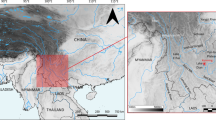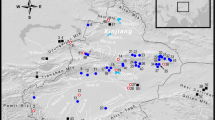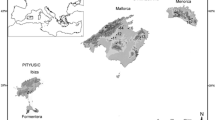Abstract
The southward spread of agriculture in China has long been regarded as a hot topic worldwide, as it is closely related to the further dispersal of farming into Southeast Asia and beyond. However, the absence of Neolithic agriculture evidence in Jiangxi province, the crossroad of the southward dispersal route, makes it difficult to confirm the specific diffusion route and triggers many debates. This study for the first time provides solid evidence of Neolithic mixed farming based on rice and foxtail millet in this region, dating back to at least 4850 cal. BP and finally bridges the gap on the proposed southward dispersal route of agriculture in China. This discovery also underlines the universality of mixed agriculture and the importance of millets in the early farming practices of Southern China.




Similar content being viewed by others
References
Barker G (2009) The agricultural revolution in prehistory: why did foragers become farmers? Oxford University, Oxford
Bellwood P (2005) First farmers: the origins of agricultural societies. Blackwell, Oxford
Bellwood P (2017) First islanders: prehistory and human migration in island Southeast Asia. Wiley Blackwell, Hoboken
Bellwood P, Chambers G, Ross M, Hung H-C (2011) Are ‘cultures’ inherited? Multidisciplinary perspectives on the origins and migrations of Austronesian-speaking peoples prior to 1000 BC. In: Roberts BW, Vander Linden M (eds) Investigating archaeological cultures. Springer, New York, pp 321–354
Bronk Ramsey C (2009) Bayesian analysis of radiocarbon dates. Radiocarbon 51:337–360
Cao K, Qi Y, Yu D (2003) Current situation and future developing strategies for the production of minor crops in Jiangxi. Jiangxi Agricultural Science and Technology 3:40–42 (in Chinese)
Chang K-C (1995) Taiwan strait archaeology and proto-Austronesian. In: Li RG, Li JK (eds) Austronesian studies relating to Taiwan. Academia Sinica, Taipei, pp161–183
Chang K-C, Goodenough WH (1996) Archaeology of southeastern coastal China and its bearing on the Austronesian homeland. Trans Am Philos Soc 86:36–56
Chen X, Zhou G, Gong W (2015) A preliminary analysis on the carbonized seeds and fruits from Niucheng site (2006-2008) Xin’gan County, Jiangxi Province. Jianghan Archaeology (Jianghan Kaogu) 3:100–115 (in Chinese)
Crowther A, Haslam M, Oakden N, Walde D, Mercader J (2014) Documenting contamination in ancient starch laboratories. J Archaeol Sci 49:90–104
Crowther A, Lucas L, Helm R, Horton M, Shipton C, Wright HT, Walshaw S, Pawlowicz M, Radimilahy C, Douka K, Picornell-Gelabert L, Fuller DQ, Boivin NL (2016) Ancient crops provide first archaeological signature of the westward Austronesian expansion. Proc Natl Acad Sci 113:6635–6640
Dai J, Zuo X, Cai X, Wen S, Jin J, Zhong L, Xia T (2019) The mixed rice and millet agriculture in Neolithic age lower Minjinag River: Phytolith evidence from Baitoushan site. Quaternary Sciences 39:161–169 (in Chinese)
Deng Z, Qin L, Gao Y, Weisskopf AR, Zhang C, Fuller DQ (2015) From early domesticated Rice of the middle Yangtze Basin to millet, Rice and wheat agriculture: archaeobotanical macro-remains from Baligang, Nanyang Basin, Central China (6700–500 BC). PLoS One 10:e0139885
Deng Z, Hung H-C, Fan X, Huang Y, Lu H (2018) The ancient dispersal of millets in southern China: new archaeological evidence. The Holocene 28:34–43
Deng Z, Fuller DQ, Chu X, Cao Y, Jiang Y, Wang L, Lu H (2020) Assessing the occurrence and status of wheat in late Neolithic Central China: the importance of direct AMS radiocarbon dates from Xiazhai. Veg Hist Archaeobotany 29:61–73
Ellis EC (2011) Anthropogenic transformation of the terrestrial biosphere. Philos Trans R Soc A Math Phys Eng Sci 369:1010–1035
Ellis EC, Kaplan JO, Fuller DQ, Vavrus S, Goldewijk KK, Verburg PH (2013) Used planet: a global history. Proc Natl Acad Sci 110:7978–7985
Fuller DQ (2010) An emerging paradigm shift in the origins of agriculture. Gen Anthropol 17:1–12
Fuller DQ (2011) Pathways to Asian civilizations: tracing the origins and spread of rice and rice cultures. Rice 4:78–92
Fuller DQ, Qin L, Zheng YF, Zhao ZJ, Chen X, Hosoya LA, Sun GP (2009) The domestication process and domestication rate in Rice: spikelet bases from the lower Yangtze. Science 323:1607–1610
Fuller DQ, Lucas L, Boivin N, Petraglia M, Crassard R (2017) Adapting crops, landscapes, and food choices: patterns in the dispersal of domesticated plants across Eurasia. In: Boivin N, Crassard R, & Petraglia M (eds) Human dispersal and species movement: from prehistory to the present. Cambridge University Press, Cambridge, pp 304–331
Gao Y, Dong G, Yang X, Chen F (2020) A review on the spread of prehistoric agriculture from southern China to mainland Southeast Asia. Science China Earth Sciences 63:615–625
Ge W, Yang S, Chen Y, Dong S, Jiao T, Wang M, Wu M, Huang Y, Fan X, Yin X, Zhang Y, Tan Q (2019) Investigating the late Neolithic millet agriculture in Southeast China: new multidisciplinary evidences. Quat Int 529:18–24
Guo Q (2009) The illustrated seeds of Chinese medicinal plants. Agricultural Publishing House, Beijing (in Chinese)
Harvey EL, Fuller DQ (2005) Investigating crop processing using phytolith analysis: the example of rice and millets. J Archaeol Sci 32:739–752
He K, Lu H, Zhang J, Wang C, Huan X (2017) Prehistoric evolution of the dualistic structure mixed rice and millet farming in China. The Holocene 27:1885–1898
Higham CF (2019) A maritime route brought first farmers to mainland Southeast Asia. In: Wu C & Rolett BV (eds) Prehistoric Maritime Cultures and Seafaring in East Asia. Springer, Singapore, pp 41–52
Hsieh J-S, Hsing Y-iC, Hsu T-f, Li PJ-k, Li K-T, Tsang C-H (2011) Studies on ancient Rice—where botanists, agronomists, archeologists, linguists, and ethnologists meet. Rice 4:178–183
Jiangxi Provincial Institute of Archaeological Research & Museum of Xin’gan County (1991) Excavation report of the Dayangzhou tomb of Shang dynasty. Cultural Relics 10:1–26 (in Chinese)
Jiangxi Provincial Institute of Archaeological Research & Museum of Zhangshu City (2005) Excavation report of the Wucheng site (1973–2002). Science Press, Beijing (in Chinese)
Jiangxi Provincial Institute of Archaeological Research & Museum of Zhangshu City (2018) Excavation report of large building remains of the Zhuweicheng site, Zhangshu city. Jiangxi province Relics from South 1:121–128 (in Chinese)
Jiangxi Provincial Institute of Archaeological Research, School of Cultural Herigtage Northwest University, Institute of Cultural Relics Management of Fuzhou City, Institute of Cultural Relics Management in Yihuang County, Institute of Cultural Relics Management in Le'an County (2015) Archaeological survey report of pre-qin sites in the Fu River valley, Jiangxi province I. Cultural Relics Press, Beijing (in Chinese)
Jiangxi Provincial Institute of Archaeological Research, School of Cultural Herigtage Northwest University, Institute of Cultural Relics Management of Fuzhou City, Institute of Cultural Relics Management of Jinxi County (2017) Archaeological survey report of pre-qin sites in the Fu River valley, Jiangxi province II. Cultural Relics Press, Beijing (in Chinese)
Jones G (1987) A statistical approach to the archaeological identification of crop processing. J Archaeol Sci 14:311–323
Jones M, Hunt H, Kneale C, Lightfoot E, Lister D, Liu X, Motuzaite-Matuzeviciute G (2016) Food globalisation in prehistory: the agrarian foundations of an interconnected continent. Journal of the British Academy 4:73–87
Larson G, Piperno DR, Allaby RG, Purugganan MD, Andersson L, Arroyo-Kalin M, Barton L, Climer Vigueira C, Denham T, Dobney K, Doust AN, Gepts P, Gilbert MTP, Gremillion KJ, Lucas L, Lukens L, Marshall FB, Olsen KM, Pires JC, Richerson PJ, Rubio de Casas R, Sanjur OI, Thomas MG, Fuller DQ (2014) Current perspectives and the future of domestication studies. Proc Natl Acad Sci 111:6139–6146
Lu H, Zhang J, Liu KB, Wu N, Li Y, Zhou K, Ye M, Zhang T, Zhang H, Yang X, Shen L, Xu D, Li Q (2009) Earliest domestication of common millet (Panicum miliaceum) in East Asia extended to 10,000 years ago. Proc Natl Acad Sci 106:7367–7372
Reimer PJ, Bard E, Bayliss A, Beck JW, Blackwell PG, Ramsey CB, Buck CE, Cheng H, Edwards RL, Friedrich M, Grootes PM, Guilderson TP, Haflidason H, Hajdas I, Hatté C, Heaton TJ, Hoffmann DL, Hogg AG, Hughen KA, Kaiser KF, Kromer B, Manning SW, Niu M, Reimer RW, Richards DA, Scott EM, Southon JR, Staff RA, Turney CSM, van der Plicht J (2013) IntCal13 and Marine13 radiocarbon age calibration curves 0–50,000 years cal. BP. Radiocarbon 55:1869–1887
Ren X, Zhu W (2007) Seeds and fruits of woody plants in China. China Forestry Publishing House, Beijing (in Chinese)
Sagart L et al. (2018) A northern Chinese origin of Austronesian agriculture: new evidence on traditional Formosan cereals. Rice 57, https://doi.org/10.1186/s12284-018-0247-9
Smith BD, Zeder MA (2013) The onset of the Anthropocene. Anthropocene 4:8–13
Tsang C-H, Li K-T, Hsu T-F, Tsai Y-C, Fang P-H, Hsing Y-IC (2017) Broomcorn and foxtail millet were cultivated in Taiwan about 5000 years ago. Botanical studies 3, https://doi.org/10.1186/s40529-016-0158-2
Wan Z, Yang X, Ge Q, Fan C, Zhou G, Jiang M (2012a) Starch grain analysis reveals late Neolithic plant utilization in the middle reaches of the Ganjiang River. Science China Earth Sciences 55:2084–2090
Wan Z, Yang X, Ge Q, Fan C, Zhou G, Ma Z (2012b) Plant resource utilization at Sheshantou site in Jiangxi Province based on starch grain analysis. Prog Geogr 31:639–645 (in Chinese)
Wang Z (1990) Farmland weeds in China: a collection of colored illustrative plates. Agricultural Publishing House, Beijing (in Chinese)
Wu X, Zhang C, Goldberg P, Cohen D, Pan Y, Arpin T, Bar-Yosef O (2012) Early pottery at 20,000 years ago in Xianrendong cave, China. Science 336:1696–1700
Xia X, Zhang P, Wu Y (2019) The analysis of rice remains from the Chaling site in the Pearl River Delta, Guangdong Province. Quaternary Sciences 39:24–36 (in Chinese)
Xu Y et al (1993) Local records of Yihuang County. Xinhua Publishing House, Beijing (in Chinese)
Yan Z, Chang J, Wang S (2018) The main discoveries from the Guodishan moated site of Yihuang County, Jiangxi province, Chinese cultural relics news, June 15th. (in Chinese)
Yang X (2017) Ancient starch research in China: Progress and problems. Quaternary Sciences 37:196–210 (in Chinese)
Yang X, Chen Q, Ma Y, Li Z, Hung HC, Zhang Q, Jin Z, Liu S, Zhou Z, Fu X (2018) New radiocarbon and archaeobotanical evidence reveal the timing and route of southward dispersal of rice farming in South China. Science Bulletin 63:1495–1501
Zhao Z (1998) The middle Yangtze region in China is one place where rice was domesticated: phytolith evidence from the Diaotonghuan cave, northern Jiangxi. Antiquity 72:885–897
Zhu F (2005) Archaeological survey report of the Niucheng site. Relics from South 4:4–7 (in Chinese)
Zuo X, Lu H, Jiang L, Zhang J, Yang X, Huan X, He K, Wang C, Wu N (2017) Dating rice remains through phytolith carbon-14 study reveals domestication at the beginning of the Holocene. Proc Natl Acad Sci 114:6486–6491
Acknowledgments
The authors are grateful to Dr. Chris Stevens for his constructive suggestions on the manuscript.
Funding
This research was funded jointly by the Strategic Priority Research Program of Chinese Academy of Sciences (grant XDB26000000) and the National Natural Science Foundation of China (grant 41872027 & 41602186).
Author information
Authors and Affiliations
Corresponding author
Ethics declarations
Conflict of interest
The authors declare that they have no conflict of interest.
Additional information
Publisher’s note
Springer Nature remains neutral with regard to jurisdictional claims in published maps and institutional affiliations.
Electronic supplementary material
ESM 1
(XLSX 14 kb)
Rights and permissions
About this article
Cite this article
Deng, Z., Yan, Z. & Yu, Z. Bridging the gap on the southward dispersal route of agriculture in China: new evidences from the Guodishan site, Jiangxi province. Archaeol Anthropol Sci 12, 151 (2020). https://doi.org/10.1007/s12520-020-01117-y
Received:
Accepted:
Published:
DOI: https://doi.org/10.1007/s12520-020-01117-y




